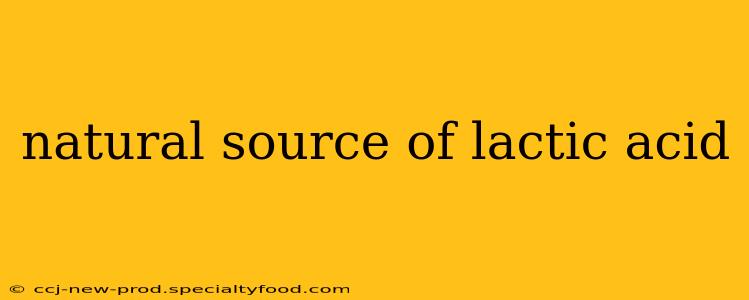Lactic acid, a naturally occurring organic compound, plays a vital role in various biological processes and has numerous applications in the food, cosmetic, and pharmaceutical industries. While often associated with muscle soreness, understanding its natural sources reveals its multifaceted nature. This article delves into the diverse origins of lactic acid, answering common questions about its presence in the natural world.
What are the main natural sources of lactic acid?
Lactic acid's primary natural sources are biological, arising from the metabolic processes of living organisms. The most prominent sources include:
-
Fermented Foods: This is arguably the most well-known source. The fermentation process, driven by lactic acid bacteria, converts sugars into lactic acid. This is why you find lactic acid in foods like yogurt, kefir, sauerkraut, kimchi, and sourdough bread. The specific bacterial strains used influence the final lactic acid concentration and the overall flavor profile of the fermented product.
-
Human and Animal Muscles: During intense exercise, when oxygen supply is limited, our muscles switch to anaerobic respiration, producing lactic acid as a byproduct. This accumulation contributes to the burning sensation and muscle fatigue we experience. Similar processes occur in the muscles of other animals.
-
Plant Tissues: While less abundant than in fermented foods or animal muscles, certain plants also contain lactic acid. The levels vary greatly depending on the plant species, growth conditions, and maturity.
-
Certain Bacteria and Fungi: Many microorganisms naturally produce lactic acid as part of their metabolic pathways. These microbes play crucial roles in various ecosystems and industrial processes.
What foods naturally contain lactic acid?
Many common foods contain lactic acid as a result of fermentation. Beyond the examples mentioned above, consider:
- Pickles: The characteristic tang of pickles results from the lactic acid produced during fermentation.
- Silage: This animal feed relies on the lactic acid fermentation of plant matter for preservation.
- Some fruits: While not a primary component, trace amounts of lactic acid can be found in certain fruits, usually as a result of microbial activity either before or after harvesting.
Is lactic acid found in human skin?
Yes, lactic acid is naturally present in human skin as part of the Natural Moisturizing Factor (NMF). It helps to maintain skin hydration and acidity (pH), contributing to a healthy skin barrier. This is one reason it’s a popular ingredient in skincare products.
How is lactic acid produced naturally?
Naturally occurring lactic acid is produced through a process called lactic acid fermentation. This process involves the action of lactic acid bacteria (LAB) on carbohydrates (sugars). LAB convert sugars into lactic acid under anaerobic conditions (without oxygen). This fermentation process is widely used in food preservation and production.
What are the benefits of lactic acid?
The benefits of lactic acid are numerous and span various applications:
- Food Preservation: It inhibits the growth of spoilage microorganisms, extending the shelf life of fermented foods.
- Skincare: Its humectant properties draw moisture to the skin, improving hydration and texture. It also helps to exfoliate dead skin cells and can improve the appearance of wrinkles.
- Pharmaceuticals: It's used in some medications and treatments.
- Bioplastics: Lactic acid is a key component in the production of biodegradable plastics, offering a sustainable alternative to petroleum-based plastics.
What are the risks or side effects of lactic acid?
In general, lactic acid is considered safe for consumption and topical application. However, some individuals may experience skin irritation or allergic reactions with topical use. High concentrations can cause burning or stinging sensations. In rare cases, excessive lactic acid buildup in the body (lactic acidosis) can be a serious medical condition.
This comprehensive overview highlights the numerous natural sources of lactic acid and its significance in diverse contexts. From the tang of yogurt to the role it plays in our muscles and skin, understanding its natural origins sheds light on its importance in our daily lives.
